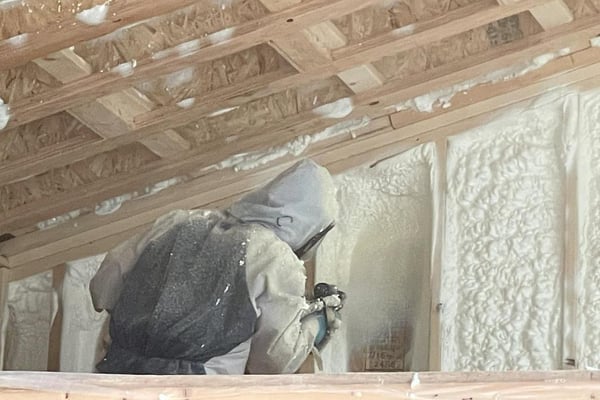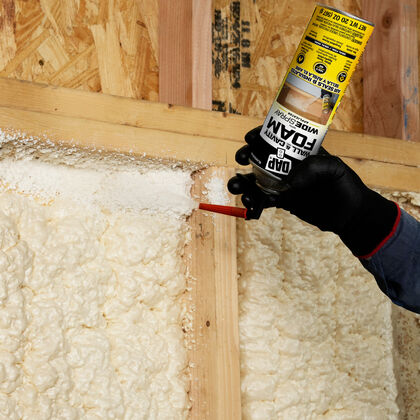The Process of Applying Spray Foam: What You Required to Know
The Process of Applying Spray Foam: What You Required to Know
Blog Article
Spray Foam: The Ultimate Service for Air Sealing and Insulation
Spray foam insulation has become a leading option for efficient air sealing and thermal insulation, supplying a special combination of residential properties that establish it besides traditional approaches. Its capacity to increase and load gaps makes it especially reliable in stopping air leakage, which can substantially impact energy performance. Recognizing the full range of its advantages, installment procedures, and comparisons with various other insulation kinds is essential for making informed choices. As we check out these facets, the implications for both brand-new constructions and retrofits end up being significantly considerable. What elements should affect your choice?
What Is Spray Foam?
Spray foam is a versatile insulation product that combines the concepts of air securing and thermal resistance to improve power performance in structures. Composed largely of polyurethane or other comparable substances, spray foam is applied as a fluid that broadens upon call with surfaces, creating a strong, continuous layer of insulation. This unique building allows it to fill up gaps, fractures, and spaces that traditional insulation products might overlook, offering a remarkable air seal.
There are 2 major kinds of spray foam: open-cell and closed-cell. Open-cell spray foam is lighter and a lot more adaptable, offering exceptional noise absorption and a reduced R-value per inch - Spray Foam. On the other hand, closed-cell spray foam is denser, offering a higher R-value, wetness resistance, and included architectural integrity to developing elements
The application process generally involves specific equipment, making certain a smooth application that adheres to various substrates, consisting of timber, steel, and concrete. This versatility makes spray foam ideal for both brand-new constructions and retrofitting existing frameworks. Its capacity to develop an impermeable obstacle dramatically adds to decreasing energy intake and boosting interior air high quality, thereby making it a recommended selection amongst contractors and property owners alike.
Benefits of Spray Foam Insulation
Among one of the most significant benefits of spray foam insulation is its remarkable capacity to produce a constant air obstacle, which properly reduces energy loss. Unlike traditional insulation products, spray foam broadens to fill cracks and voids, making certain that air leakage is significantly lowered. This particular not just boosts power effectiveness however likewise results in decrease energy bills in time.
Furthermore, spray foam insulation gives exceptional thermal resistance, adding to a much more steady interior environment. Its high R-value per inch enables efficient insulation in restricted spaces, making it optimal for attics, wall surfaces, and crawl areas. The moisture-resistant homes of spray foam help stop mold and mildew development, advertising healthier living conditions.
Another important advantage of spray foam insulation is its sound-dampening top qualities (Spray Foam). It properly decreases sound transmission between spaces, developing a quieter and extra comfy home environment. The longevity of spray foam additionally stands apart, as it does not sag or clear up gradually, keeping its efficiency throughout its lifespan
Exactly How Spray Foam Works
Understanding how spray foam insulation functions is essential for appreciating its effectiveness in air securing and thermal resistance. Spray foam insulation contains two primary components: isocyanate and polyol resin. When these components are mixed, they undertake a chemical response that causes the product to expand swiftly, producing a thick foam that fills voids, splits, and dental caries.
As the foam expands, it complies with surface areas, developing an airtight seal that considerably reduces air seepage. This characteristic makes spray foam insulation very effective at protecting against drafts and wetness infiltration, which can cause power loss and damage with time. Additionally, the closed-cell version of spray foam offers premium thermal resistance as a result of its stiff structure, effectively lessening heat transfer.
The unique buildings of spray foam permit it to comply with uneven surface areas, making sure extensive coverage and a smooth barrier. Therefore, spray foam insulation not just boosts energy efficiency yet likewise adds to boosted indoor air top basics quality by minimizing the accumulation of irritants and contaminants. Inevitably, recognizing the mechanics behind spray foam emphasizes its role as an exceptional choice for insulation and air sealing in both domestic and business applications.
Installation Process Introduction

Prior to installment, the area has to be sufficiently cleaned up and prepped, ensuring that surfaces are without moisture, debris, and dust. Due to the fact that pollutants can endanger attachment and overall efficiency, this step is critical. Once the area is prepared, the application entails mixing the two components of the spray foam, which broadens upon contact and fills up gaps properly.
Educated specialists must carry out the installation, using customized tools to ensure uniform protection and optimal density. Security precautions, consisting of wearing protective gear and making certain appropriate ventilation, are imperative during this procedure. After application, the foam normally remedies rapidly, forming a solid obstacle that improves energy performance.
Contrasting Spray Foam to Conventional Insulation
When assessing insulation alternatives, spray foam insulation stands out in contrast to conventional materials such as fiberglass and cellulose. Unlike fiberglass and cellulose, which can allow air infiltration, spray foam broadens upon application, loading spaces and gaps to create an impermeable seal.
Furthermore, spray foam offers a read this higher R-value per inch than typical insulation kinds, supplying even more effective thermal resistance in a thinner profile. This characteristic is particularly helpful in rooms with limited cavity deepness. Additionally, spray foam is resistant to moisture and mold and mildew growth, which can be a considerable issue with cellulose and fiberglass, particularly in damp atmospheres.
Nonetheless, spray foam insulation generally brings a higher ahead of time cost than its conventional equivalents. Homeowners must evaluate this preliminary investment versus long-lasting energy financial savings and performance advantages. Eventually, while both insulation types offer their function, spray foam emerges as an advanced option for contemporary insulation requirements, particularly in terms of air sealing and thermal performance.

Verdict
In recap, spray foam insulation represents a very effective remedy for achieving optimum air sealing and thermal resistance. Its one-of-a-kind homes, consisting of moisture resistance and sound dampening, make it ideal for different applications in both new buildings and retrofitting jobs (Spray Foam). The initial prices might be higher contrasted to standard insulation products, the long-lasting advantages, such as substantial energy savings and improved indoor air top quality, warrant the investment and emphasize its worth in modern-day structure techniques.
Spray foam insulation has actually arised as a leading option for efficient air sealing and thermal insulation, using a special mix of properties that establish it apart from standard approaches.Spray foam is a versatile insulation material that incorporates the concepts of air securing and thermal click resistance to improve power effectiveness in structures.When evaluating insulation alternatives, spray foam insulation stands out in contrast to traditional materials such as fiberglass and cellulose. Inevitably, while both insulation types serve their purpose, spray foam emerges as an extra advanced remedy for contemporary insulation demands, specifically in terms of air sealing and thermal effectiveness.
In recap, spray foam insulation stands for a very reliable service for attaining optimum air sealing and thermal resistance.
Report this page